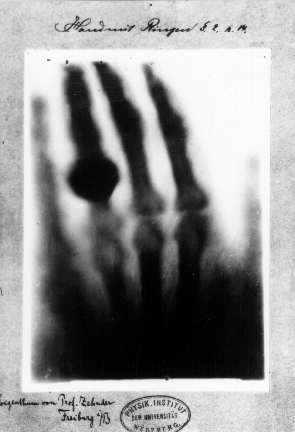Wilhelm Röntgen
Wilhelm Conrad Röntgen (27 March 1845 – 10 February 1923) was a German mechanical engineer and physicist, who, on 8 November 1895, produced and detected electromagnetic radiation in a wavelength range known as X-rays or Röntgen rays, an achievement that earned him the first Nobel Prize in Physics in 1901. His discovery of X-rays marked a significant milestone in the field of physics and medicine, revolutionizing diagnostic practices and opening new avenues in scientific research.
Early Life and Education[edit | edit source]
Wilhelm Röntgen was born in Lennep, Prussia (now a part of Remscheid, Germany). He attended the Technical School in Utrecht, Netherlands. However, due to being expelled for a prank another student had committed, Röntgen could not attend university in the Netherlands. He eventually moved to Switzerland and enrolled at the ETH Zurich (Swiss Federal Polytechnic School), where he studied mechanical engineering, receiving his diploma in 1869. Röntgen continued his studies in physics under August Kundt and obtained his PhD from the University of Zurich in 1869.
Career[edit | edit source]
After completing his education, Röntgen held various academic positions. He worked as a lecturer at the University of Strasbourg, a professor at the University of Giessen, and later at the University of Würzburg, where he made his groundbreaking discovery. Throughout his career, Röntgen focused on experimental physics, exploring phenomena related to heat, electricity, and other areas before his work with X-rays.
Discovery of X-rays[edit | edit source]
On 8 November 1895, while experimenting with cathode rays, Röntgen observed a glow emanating from a nearby chemically coated screen. He deduced that the glow was caused by a previously unknown type of ray, which he temporarily dubbed "X-rays" for their unknown nature. Röntgen found that these rays could pass through most substances but left shadows of solid objects such as bones on photographic plates. Realizing the significance of his discovery, he conducted further experiments and on 28 December 1895, published his findings in a paper titled "On a New Kind of Rays."
Impact and Legacy[edit | edit source]
Röntgen's discovery of X-rays transformed diagnostic medicine by allowing doctors to see inside the human body without surgery. This breakthrough also spurred numerous advancements in physics, chemistry, and other scientific fields. Röntgen refused to patent his discovery, opting instead to freely share it with the world for the benefit of humanity.
Despite his monumental discovery, Röntgen remained a modest and private individual, avoiding the limelight and continuing his work in physics until his retirement. He donated the money from his Nobel Prize to the University of Würzburg. Röntgen passed away on 10 February 1923 in Munich, Germany.
Awards and Honors[edit | edit source]
For his discovery of X-rays, Wilhelm Röntgen received numerous accolades, including the first Nobel Prize in Physics in 1901. He was also awarded the Matteucci Medal in 1896 and the Rumford Medal in 1896. Röntgen's legacy is honored in various ways, including the naming of the element roentgenium, a chemical element with the symbol Rg and atomic number 111, after him.
See Also[edit | edit source]
Navigation: Wellness - Encyclopedia - Health topics - Disease Index - Drugs - World Directory - Gray's Anatomy - Keto diet - Recipes
Search WikiMD
Ad.Tired of being Overweight? Try W8MD's physician weight loss program.
Semaglutide (Ozempic / Wegovy and Tirzepatide (Mounjaro) available.
Advertise on WikiMD
WikiMD is not a substitute for professional medical advice. See full disclaimer.
Credits:Most images are courtesy of Wikimedia commons, and templates Wikipedia, licensed under CC BY SA or similar.
Contributors: Prab R. Tumpati, MD






